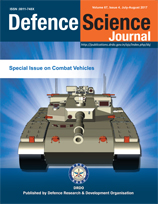Design Analysis of Brushless Direct Current Generator
DOI:
https://doi.org/10.14429/dsj.67.11546Keywords:
BLDC generator, Electromagnetic simulation, Conjugate heat transfer, Frozen rotor method, Computational fluid dynamicAbstract
In this work, optimisation of a brushless direct current (BLDC) generator design was undertaken by carrying out an electromagnetic and computational fluid dynamic study. The studies were carried out for different loading-overloading conditions and angular speeds, keeping in consideration the required electrical and thermal parameters, firstly for the initial design and then for optimised designs. In the initial phase, transient electromagnetic simulations were done using Ansys Maxwell to estimate power output, flux densities, heat losses et al. In the next phase, steady state conjugate heat transfer simulations using frozen rotor method for rotating domains were carried out in Ansys CFX using the heat loss values obtained from electromagnetic study in the first phase. The results from conjugate heat transfer were obtained in the form of temperature and flow parameters. After a thorough study and comparison of the results for different designs, obtained in the two phases, it was seen one of the optimised designs showed better electromagnetic, thermal and flow parameters as compared to the initial design and satisfied all the optimum electrical and thermal parameters.
Downloads
Published
How to Cite
Issue
Section
License
 Where otherwise noted, the Articles on this site are licensed under Creative Commons License: CC Attribution-Noncommercial-No Derivative Works 2.5 India
Where otherwise noted, the Articles on this site are licensed under Creative Commons License: CC Attribution-Noncommercial-No Derivative Works 2.5 India


